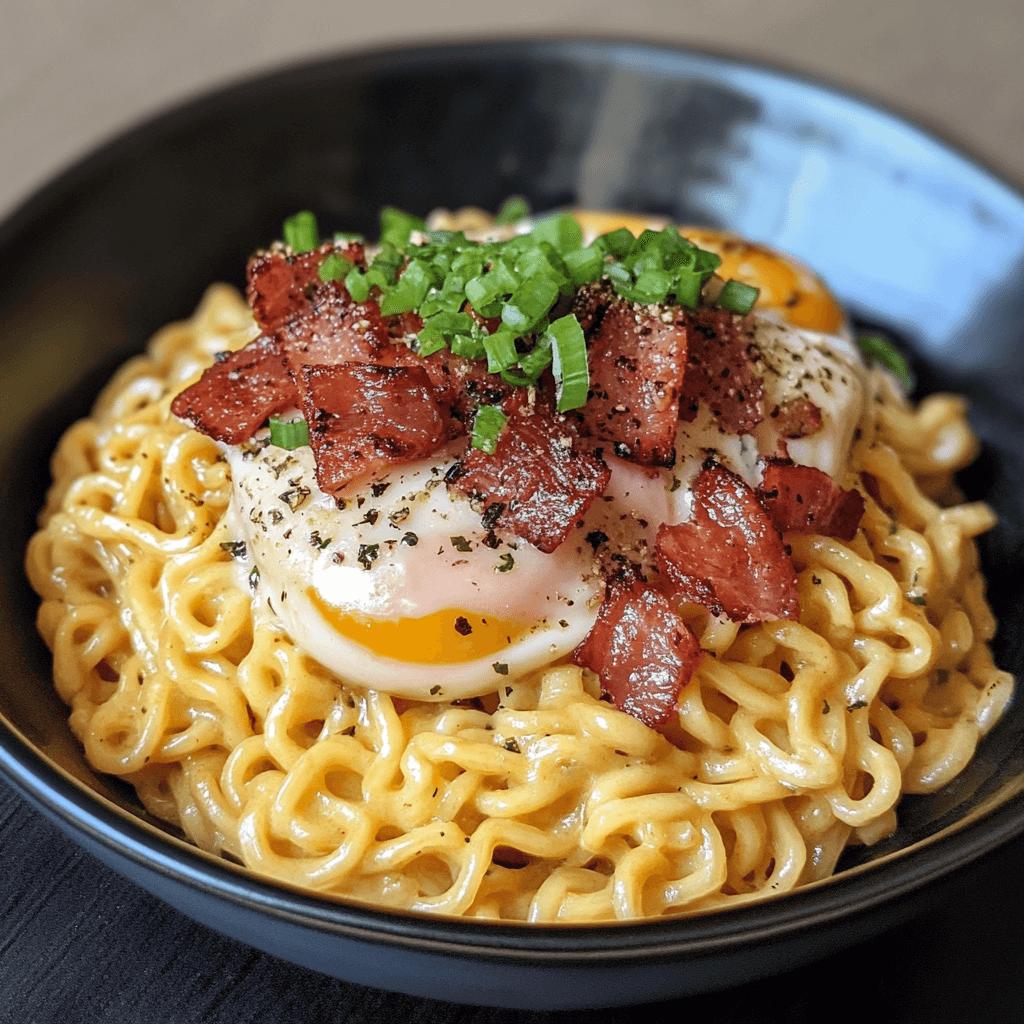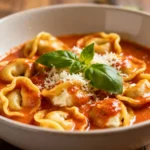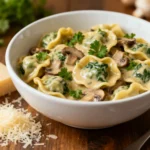Introduction
Carbonara Ramen is a delicious fusion dish that combines the comforting flavors of Italian carbonara with the satisfying texture and broth of Japanese ramen. This recipe brings together rich, creamy egg-based sauce with savory pork, smoky bacon, and perfectly cooked noodles for a meal that’s both indulgent and easy to prepare.
The History
Ramen, originating from Japan, has evolved over centuries into one of the world’s most beloved comfort foods. Meanwhile, Carbonara, an iconic Roman pasta dish, dates back to post-World War II Italy when ingredients like eggs, cheese, and pancetta became more accessible. The marriage of these two culinary traditions reflects modern global cuisine trends where cultures blend seamlessly, creating unique dishes such as Carbonara Ramen.
Ingredients Breakdown
- Ramen Noodles: Store-bought or homemade noodles provide the base of this dish.
- Eggs: Used raw in traditional carbonara recipes; they emulsify and thicken the sauce without cooking directly on heat.
- Cheese: Parmesan or Pecorino Romano adds sharpness and creaminess.
- Bacon: Smoked and crispy, it provides umami flavor and texture contrast.
- Garlic: Adds aromatic depth to the dish.
- Soy Sauce: Complements the ramen broth while enhancing overall saltiness.
- Freshly Ground Pepper: A key component in authentic carbonara, black pepper elevates the taste profile significantly.
- Optional Toppings: Green onions, chili flakes, nori sheets, or soft-boiled eggs can enhance presentation and flavor.
Step-by-Step Recipe
- Cook the Ramen: Bring a pot of water to boil, then cook your chosen ramen noodles according to package instructions until al dente. Reserve some noodle water before draining.
- Prepare Bacon: In a large skillet over medium heat, fry sliced bacon until golden brown and crispy. Remove excess fat but leave about 2 tablespoons in the pan.
- Sauté Garlic: Add minced garlic to the rendered bacon fat and sauté briefly until fragrant—about 30 seconds.
- Create Sauce Base: Turn off the heat and whisk in beaten eggs, grated Parmesan/Pecorino Romano, soy sauce, and freshly ground black pepper. Stir continuously so the residual heat gently warms the mixture without scrambling the eggs.
- Toss Ingredients Together: Combine cooked ramen noodles with the sauce in the skillet, tossing everything thoroughly to coat evenly. If needed, add reserved noodle water tablespoon by tablespoon to achieve desired consistency.
- Serve Hot: Divide portions among bowls, garnish with toppings (green onions, chili flakes, etc.), and serve immediately.
Tips
- Use Fresh Eggs: Fresher eggs create silkier textures and richer flavors in carbonara-style sauces.
- Don’t Overcook: Avoid prolonged exposure of eggs to direct heat to prevent curdling. Work quickly after removing the skillet from flame.
- Adjust Seasoning Gradually: Taste as you go since different brands of soy sauce and cheeses may vary in saltiness.
- Experiment with Proteins: Substitute bacon with chicken thigh strips, ground pork, or even mushrooms for vegetarian versions.
Variations and Customizations
This versatile dish invites creativity! For example:
- Veggie Version: Replace bacon with roasted cherry tomatoes, zucchini ribbons, or sautéed spinach.
- Spicy Kick: Incorporate red pepper flakes or sriracha into the sauce for heat enthusiasts.
- Broth-Based Option: Pour leftover ramen broth over the finished dish for added moisture and complexity.
- Gourmet Upgrade: Finish with truffle oil or shaved fresh truffles for an elevated dining experience.
Health Considerations and Nutritional Value
While Carbonara Ramen is undeniably decadent, its nutritional value depends heavily on portion sizes and ingredient choices. Here are some points to consider:
- Protein Powerhouse: Eggs, cheese, and bacon deliver high-quality proteins essential for muscle repair and growth.
- Carbohydrates: Ramen supplies quick energy through refined carbs, though whole-grain alternatives exist if preferred.
- Fat Content: Rich in healthy fats from eggs and cheese, but also saturated fats from bacon; moderation is key.
- Sodium Levels: Soy sauce and cheese contribute significant sodium, so monitor intake especially for those sensitive to salt.
Ingredients
- 8 oz ramen noodles
- 4 large eggs
- 1 cup grated Parmesan or Pecorino Romano cheese
- 6 slices bacon, diced
- 2 cloves garlic, minced
- 2 tbsp soy sauce
- Ground black pepper, to taste
- Garnishes: chopped green onions, chili flakes, nori strips
Directions
(Refer to Step-by-Step Recipe section above.)
FAQ
- Can I use instant ramen instead of fresh?
- Yes, though results might differ slightly due to variations in texture and thickness between instant and fresh varieties.
- What substitutes work well for bacon?
- Try pancetta, prosciutto, turkey bacon, or omit entirely for a plant-based option using smoked tofu or tempeh.
- Why do we turn off the heat before adding eggs?
- To avoid scrambling them; residual heat gently cooks the eggs while maintaining creaminess.
- How long does Carbonara Ramen stay good in the fridge?
- Up to three days when stored properly in an airtight container. Reheat gently to preserve texture.
Summary
Carbonara Ramen blends Italian elegance with Asian simplicity, offering a hearty yet sophisticated dish perfect for weeknights or special occasions. By combining classic carbonara elements with ramen’s slurp-worthy appeal, this creation satisfies cravings while encouraging personalization.










